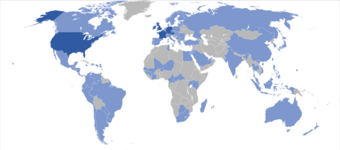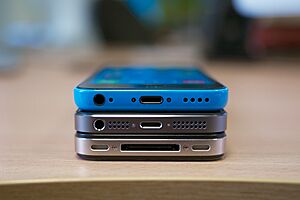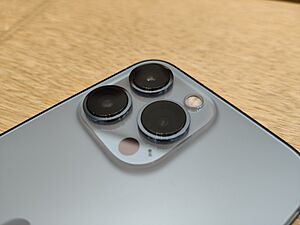- This page was last modified on 17 October 2025, at 10:18. Suggest an edit.
iPhone facts for kids
For other uses, see iPhone (disambiguation).
 |
|
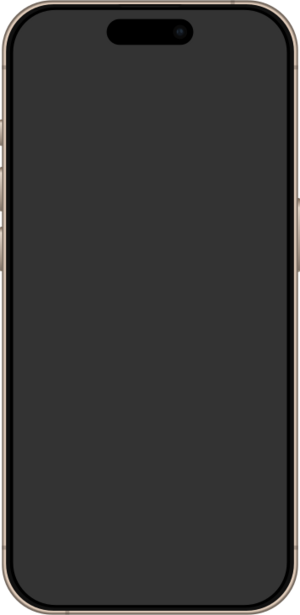
Front face of the latest flagship model, the iPhone 16 Pro, in Desert Titanium
|
|
| Developer | Apple |
|---|---|
| Manufacturer | Contract manufacturers:
|
| Type | Smartphone |
| Release date | June 29, 2007 |
| Units sold | 2.3 billion (as of January 1, 2024[update]) |
| Operating system | iOS |
| Storage | 128, 256, 512 GB or 1 TB flash memory (current models) |
| Sound | |
| Power | Built-in rechargeable lithium-ion battery |
| Online services | |
| Related |
|
The iPhone is a type of smartphone made by Apple. It runs on Apple's own mobile operating system called iOS. The very first iPhone was shown by Apple's co-founder Steve Jobs on January 9, 2007. It was released later that year.
Since then, Apple has released new iPhone models and iOS versions every year. The newest models are the iPhone 16 and 16 Plus, the advanced iPhone 16 Pro and 16 Pro Max, and the more affordable iPhone 16e. As of January 1, 2024, over 2.3 billion iPhones have been sold. This makes Apple the biggest seller of mobile phones in 2023.
The first iPhone was special because it used multi-touch technology. Over time, iPhones have gotten bigger, clearer screens (like the Retina display), and can record videos. They also became waterproof and gained many helpful accessibility features. Older iPhones (up to the iPhone 8) had a single button on the front. The iPhone 5s and newer models added a Touch ID fingerprint sensor to this button. Starting with the iPhone X, iPhones changed to a screen that covers almost the whole front. They use Face ID (facial recognition) instead of Touch ID and rely more on gestures for navigation.
The iPhone uses Apple's special iOS software. It is one of the two main smartphone systems in the world, along with Android. Steve Jobs called the first iPhone a "revolution" for phones. The iPhone helped make the flat, rectangular smartphone shape popular. It also created a huge market for smartphone apps, known as the "app economy." This set the stage for the big growth in mobile devices. Besides the apps that come with iOS, there are almost 2 million apps available to download from Apple's App Store.
Contents
History of the iPhone
Early Development (2000s)
Work on an Apple smartphone began in 2004. A team of 1,000 employees, led by Tony Fadell, Scott Forstall, and Jony Ive, worked on a secret project called "Project Purple."
Apple CEO Steve Jobs decided to focus on a phone instead of a tablet first. (The tablet idea was later used for the iPad.) Apple worked secretly with Cingular Wireless (now AT&T Mobility) to create the iPhone. This project cost about US$150 million over thirty months. Jobs said the "i" in "iMac" (and later "iPod," "iPhone," and "iPad") stands for internet, individual, instruct, inform, and inspire.
Apple did not want to repeat the mistakes of the Motorola ROKR E1. This "iTunes phone" was made with Motorola but was not very successful. Cingular let Apple develop the iPhone's hardware and software on its own. This was unusual at the time. Cingular also paid Apple a part of its monthly service money for four years of exclusive sales in the U.S.
Jobs showed the first iPhone to the public on January 9, 2007, at the Macworld convention. The iPhone had a 3.5-inch multi-touch screen with few buttons. It ran the iPhone OS operating system, which was easy to use with touch. It was the first phone to use multi-touch. The iPhone was released on June 29, 2007, starting at US$499 in the U.S. It required a two-year contract with AT&T. The price was lowered after two months, which led to some complaints from early buyers.
On July 11, 2008, Apple announced the iPhone 3G at its Worldwide Developers Conference (WWDC). It was available in 22 countries on launch day and later in 70 countries. The iPhone 3G brought faster 3G internet and a lower starting price of US$199. It became very popular, even outselling the Motorola RAZR V3 in the U.S. by the end of 2008. Its next version, the iPhone 3GS, was announced on June 8, 2009. It added video recording.
Innovations in the 2010s
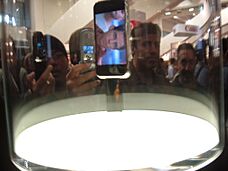
The original iPhone on display under glass at the January 2007 Macworld show
The iPhone 4 was announced on June 7, 2010. It had a new design with a stainless steel frame and a glass back. It was marketed as the "world's thinnest smartphone" at the time. It used the Apple A4 processor, which was Apple's first custom-designed chip for an iPhone. It also introduced the Retina display, which had a much higher display resolution than older iPhones. A front-facing camera was added for video calls using FaceTime.
Some iPhone 4 users reported losing calls when holding their phones in a certain way. This issue was called "antennagate." In January 2011, Verizon started selling the iPhone 4, as Apple's special deal with AT&T ended.
The iPhone 4s was announced on October 4, 2011. It introduced the Siri virtual assistant, a faster A5 processor, and an 8-megapixel camera that could record 1080p video. The iPhone 5 was announced on September 12, 2012. It had a larger 4-inch screen, up from 3.5 inches on previous models. It also had faster 4G LTE internet. The iPhone 5 was thinner and lighter, made of aluminum alloy. The old 30-pin dock connector was replaced with the new, reversible Lightning connector.
The iPhone 5s and iPhone 5c were announced on September 10, 2013. The iPhone 5s had a 64-bit A7 processor, making it the first 64-bit smartphone. It also introduced the Touch ID fingerprint sensor. The iPhone 5c was a cheaper phone with iPhone 5 parts, but it came in colorful plastic cases.
On September 9, 2014, Apple introduced the iPhone 6 and iPhone 6 Plus. These had much larger screens: 4.7-inch and 5.5-inch. Both models also added Apple Pay for mobile payments. The 6 Plus camera gained Optical image stabilization. The Apple Watch was also introduced that day, working with an iPhone. Some users found that the iPhone 6 and 6 Plus could bend with normal use, especially the larger model. This was called "bendgate."
The iPhone 6s and 6s Plus were released on September 9, 2015. They had a stronger aluminum frame to prevent bending. Their main camera was improved to 12 megapixels and could record 4K video. The first iPhone SE came out on March 21, 2016. It was a more affordable phone that put newer iPhone 6s parts into the smaller body of the older iPhone 5s.
The iPhone 7 and 7 Plus were announced on September 7, 2016. They had better camera sensors, were water and dust resistant (IP67), and used a powerful A10 Fusion processor. The 3.5 mm headphone jack was removed, leading to the introduction of AirPods wireless earbuds. The iPhone 7's camera gained optical image stabilization. The 7 Plus added a second telephoto camera lens for 2x optical zoom and a "Portrait" mode that blurs the background.
The iPhone 8, 8 Plus, and iPhone X were announced on September 12, 2017. All models had glass backs like the iPhone 4, wireless charging, and a powerful A11 Bionic chip with special AI hardware. The iPhone X also featured a 5.8-inch OLED "Super Retina" display that covered almost the entire front. It had a higher pixel density and contrast ratio than older iPhones with LCD screens. It also had a stronger stainless steel frame. The iPhone X introduced Face ID facial recognition in a "notch" cutout at the top of the screen, replacing Touch ID. The home button was removed, and navigation was done with gestures. At US$999, the iPhone X was the most expensive iPhone when it launched.
The iPhone XR, iPhone XS, and XS Max were announced on September 12, 2018. All models included "Smart HDR" for better photos and a much more powerful "Neural Engine." The XS Max had a larger 6.5-inch screen. The iPhone XR had a 6.1-inch LCD "Liquid Retina" display with a similar full-screen design to the iPhone X, but it did not have a second telephoto camera. It came in many bright colors, like the iPhone 5c, and was a cheaper option than the iPhone X and XS.
The iPhone 11, 11 Pro, and 11 Pro Max were announced on September 10, 2019. The iPhone 11 replaced the iPhone XR, while the 11 Pro and 11 Pro Max replaced the iPhone XS and XS Max. All models gained an Ultra-Wide camera lens, allowing for 2x optical zoom out. They also had bigger batteries for longer life. The second-generation iPhone SE was introduced on April 17, 2020. It was a low-cost phone that used newer iPhone 11 parts in the body of the older iPhone 8, keeping the home button and Touch ID sensor.
Recent Models (2020s)
The iPhone 12, 12 Mini, 12 Pro, and 12 Pro Max were announced on October 13, 2020. All models featured OLED "Super Retina XDR" displays and introduced faster 5G internet. They also brought back the MagSafe magnetic charging and accessory system. A thinner, flat-edged design was introduced, along with stronger glass-ceramic front glass for better drop protection. The iPhone 12 Mini had a smaller 5.4-inch screen. The 12 Pro and 12 Pro Max had larger screens of 6.1-inch and 6.7-inch. The iPhone 12 Pro and 12 Pro Max also added a Lidar sensor for better augmented reality (AR) apps.
The iPhone 13, 13 Mini, 13 Pro, and 13 Pro Max were announced on September 14, 2021. All models had larger camera sensors, bigger batteries, and a smaller "notch" cutout. The iPhone 13 Pro and 13 Pro Max also introduced smoother, adaptive 120 Hz refresh rate "ProMotion" technology for their OLED displays. Their telephoto lens gained 3x optical zoom. The affordable third-generation iPhone SE was introduced on March 8, 2022. It used the A15 Bionic chip from the iPhone 13 but was otherwise similar to the second-generation iPhone SE.
The iPhone 14, 14 Plus, 14 Pro, and 14 Pro Max were announced on September 7, 2022. All models introduced satellite phone emergency calling. A new 14 Plus model brought the large 6.7-inch screen size (first seen on the iPhone 12 Pro Max) to a more affordable phone. The iPhone 14 Pro and 14 Pro Max also introduced a higher-resolution 48-megapixel main camera, the first increase in megapixels since the iPhone 6s. They also added always-on display to the lock screen and an interactive status bar interface called "Dynamic Island."
The iPhone 15, 15 Plus, 15 Pro, and 15 Pro Max were announced on September 12, 2023. These models switched to using USB-C as their charging port to follow European Commission rules. This replaced Apple's own Lightning connector after eleven years. The 15 and 15 Plus now feature the Dynamic Island (which first appeared on the iPhone 14 Pro), a 48-megapixel main camera, slightly curved edges, and a frosted glass back with color infused. The 15 Pro and Pro Max also replaced the mute switch with an "Action" button and changed from stainless steel to titanium.
The iPhone 16, 16 Plus, 16 Pro, and 16 Pro Max were announced on September 9, 2024. The 16 and 16 Plus introduced a vertical camera layout with improved "Fusion" and Ultra-Wide cameras. The 16 Pro and Pro Max have larger 6.3-inch and 6.9-inch displays, a 48-megapixel Ultra-Wide camera, and the biggest batteries in an iPhone yet. All models now include new Apple Intelligence AI features, a better cooling system, support for Wi-Fi 7, and a new "Camera Control" button for easier camera access. On February 19, 2025, the 16e was announced as the newest member of the 16 family. This model has longer battery life thanks to the A18 chip and the new Apple C1, Apple's first cellular modem. It has a 6.1-inch screen and the same 48-megapixel camera as previous models, but it lacks the wider shot option due to its lower price.
iPhone Models
Apple has made 46 iPhone models. The models in bold are the newest ones currently available:
| Release date | Model | System-on-a-chip |
|---|---|---|
| September 22, 2023 | iPhone 15 | Apple A16 |
| iPhone 15 Plus | ||
| September 20, 2024 | iPhone 16 | Apple A18 |
| iPhone 16 Plus | ||
| iPhone 16 Pro | Apple A18 Pro | |
| iPhone 16 Pro Max | ||
| February 28, 2025 | iPhone 16e | Apple A18 |
How iPhones are Made
Up until the iPhone 4, all iPhones and other Apple devices like iPod Touch and iPads were made by Foxconn in Taiwan. In 2011, Apple's new CEO Tim Cook decided to use more than one company to make their products. The iPhone 4s in 2012 was the first model made by two companies: Foxconn and Pegatron, also from Taiwan. Foxconn still makes most iPhones, but Pegatron's share has grown. For example, Pegatron made some of the iPhone 5c in 2013 and 30% of iPhone 6 devices in 2014. The 6 Plus model was made only by Foxconn. In 2019, Apple looked into reports that some Foxconn managers used rejected parts to build iPhones. In India, Apple pays Wistron, another Taiwan-based company, to assemble iPhones for sale in that region.
In 2022, Apple announced that some iPhone 14 models would be made in Tamil Nadu, India. This was because China's "zero-COVID" policy was causing problems for global supply chains. Apple plans to move 25% of iPhone production to India by 2025.
iPhone Parts and Features
Apple hires other companies to make the actual parts for the iPhone, but Apple keeps strong control over the final product. The iPhone has most of the parts you would find in a modern smartphone. Some parts, like 3D Touch and the Taptic Engine, are special to the iPhone. The main part of the iPhone is its touchscreen, with current models having screens 4.7 inches or larger. All iPhones have a camera on the back. The front-facing camera was added with the iPhone 4. The iPhone 7 Plus was the first to have multiple lenses for the back camera.
iPhones also include many sensors, such as:
- A proximity sensor (turns off the screen when you hold it to your ear)
- An ambient light sensor (adjusts screen brightness)
- An accelerometer (detects movement and orientation)
- A gyroscopic sensor (helps with rotation and balance)
- A magnetometer (a compass)
- A facial recognition sensor or fingerprint sensor (for unlocking, depending on the model)
- A barometer (measures air pressure)
In 2022, Apple added satellite communication to the iPhone with the release of the iPhone 14 and iPhone 14 Pro.
iPhone Software
Operating System
The iPhone runs iOS. This operating system is based on parts of Apple's computer operating system, macOS. The iPhone comes with many apps already installed by Apple. You can also download other apps from the App Store.
Apple provides free updates to iOS over the internet or through Finder and iTunes on a computer. New iPhone models usually come out with a major new iOS version. The most recent version is iOS 18.
App Store and Apps
On June 11, 2007, Apple announced that the iPhone would support web apps that looked and felt like iPhone apps. Later, on October 17, 2007, Steve Jobs said that a software development kit (SDK) would be available for app makers in February 2008. The iPhone SDK was released on March 6, 2008. The App Store opened on July 11, 2008, with the release of iPhone OS 2.0.
Apple requires all apps to be downloaded from the App Store, except for special apps used by businesses. App developers pay a yearly fee to Apple. If their membership ends, their apps are removed from the App Store, but people who already have the app can still redownload it. Developers can make free apps or paid apps. Apple takes a 30% share of sales from paid apps. Developers who earn less than $1 million a year can join a special program where Apple only takes a 15% fee.
Even though Android has more users, many people say iOS has better apps. This is because iOS apps are often higher quality, and more apps are made only for iOS first. Android's many different versions, less standard hardware, and lower app earnings are some reasons for this.
All apps must be reviewed by Apple before they can be put on the App Store. Apple can also stop selling apps it thinks are not appropriate. For example, in 2009, Apple removed a Newspapers app because of "obscene" content. In 2018, Apple removed Tumblr from the App Store due to illegal content, which led Tumblr to ban all adult content. Some app developers have said Apple's review process is "frustrating" and "unfair."
Users can also install apps outside the App Store by "jailbreaking" their iPhone or using special exploits. Jailbreaking can cause security problems and is not supported by Apple.
As of August 2024, Apple's App Store has almost 2 million applications.
Jailbreaking iPhones
Apple limits what apps can be installed and does not allow full access to the iPhone's files. Jailbreaking lets users install apps not on the App Store, change their device in ways Apple doesn't allow, and remove SIM locks. Some features that were first available through jailbreaking were later added by Apple into iOS, like multitasking, widgets, and copy and paste.
Apple tried to stop jailbreaking using a law called the DMCA. However, in 2010, the U.S. ruled that jailbreaking is legal. Jailbroken iPhones might be more at risk from harmful software because Apple has less control over the apps. In the United States, Apple cannot cancel an iPhone's warranty just because it was jailbroken. Jailbreaks use special tricks or exploits. Apple has made iPhones more secure, making these tricks harder to find. Because of this, newer iPhones cannot currently be jailbroken.
Accessibility Features
The iPhone has many accessibility features to help users with vision, hearing, and movement needs. iPhones can alert users with messages on screen, sounds, vibrations, or the camera's LED flash. Users can even create their own vibration patterns. Since iOS 15, Siri can read notifications aloud through headphones, and since iOS 16, through the phone's speakers.
Users with movement needs can use Assistive Touch to change how they navigate menus. It helps users who have trouble with gestures like pinching, making them available by tapping a menu. Users can create their own gestures and change the AssistiveTouch menu layout. If pressing the Home button is hard, it can be activated with an onscreen tap. Gestures like rotating and shaking are available even if the iPhone is mounted on a wheelchair. Head Tracking can control an iPhone using face movements seen by the front camera.
For users with low vision, VoiceOver can be turned on. This screen reader describes what is on the screen. Siri allows hands-free interaction. The iPhone also supports wireless braille displays to help users read the interface. Text can be made larger across the whole system. The Magnifier app uses the iPhone's Lidar scanner to find objects like doors, people, and other items. It can describe them to the user and tell their distance. Door Detection can alert users with sound, speech, and vibrations.
Hearing aids that are part of the Made for iPhone program can be controlled from an iPhone. These hearing aids also have Live Listen, which lets the iPhone act as a microphone, sending audio to compatible hearing aids. Live Listen can help users hear conversations in noisy rooms or hear someone speaking from across the room. Apple built Live Listen support into all AirPods, which can also send audio from a connected iPhone's microphone. Closed captioning and external TTY devices are supported. Live Caption can write down audio from all apps and show it on screen. Sound Recognition can identify sounds around you, like doorbells, kettles, running water, and babies crying, and notify the user with an onscreen alert.
Guided Access helps people with autism, ADHD, or sensory challenges stay focused on one app. With Guided Access, a parent, teacher, or therapist can keep an iPhone on one app by disabling the Home button and limiting the time spent in an app. Users can also restrict access to the keyboard or touch input on certain parts of the screen.
Marketing and Sales
The first iPhone was heavily promoted before it was officially announced, creating a lot of excitement. When it was released, it was advertised a lot on TV, the internet, and in print ads.
Apple's strategy of selling the iPhone at a higher price has made it seem like a special item.
The Apple ecosystem (how Apple devices and services work together) is a big reason why people stay loyal to iPhones. iMessage is a good example. SMS messages from Android users appear as green bubbles, while texts from other iPhone users are blue. Before Rich Communication Services (RCS) support was added in iOS 18 in 2024, group chats between iOS and Android users were not very good. Reactions showed up as text, and pictures sent through MMS had lower quality. Some teens have said they felt left out after switching to Android. Critics say this is a big reason why 88% of U.S. teenagers use iPhones.
SIM Unlocking
Many iPhones bought with a monthly carrier contract are SIM locked. This means they can only be used with that one carrier. The first iPhone was only sold in the U.S. on the AT&T network with a SIM lock. However, some clever people found ways to get around this lock. More than a quarter of the first iPhones sold in the U.S. were not registered with AT&T. Apple thought these were probably sent overseas and unlocked, which was a profitable market before the iPhone 3G was released worldwide. Today, many carriers either remove the SIM lock automatically after a certain time or do it if you ask, sometimes for free or a small fee. iPhones bought directly from Apple are not SIM locked. Many carriers also sell unlocked iPhones if you buy them outright instead of with a long-term contract.
Retail Strategy
Since 2013, iPhone buyers can get a trade-in discount when buying a new iPhone directly from Apple. This program aims to get more customers to buy iPhones at Apple Stores instead of carrier stores. In 2015, Apple launched the iPhone Upgrade Program, a 24-month leasing plan. This program changed how iPhone owners relate to mobile carriers.
Repairing iPhones
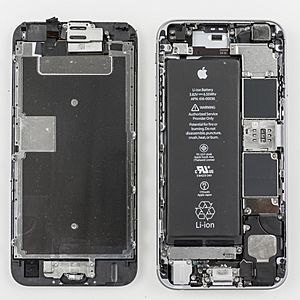
iPhone 6s's interior; the side on the left contains the display and the side on the right contains hardware and battery
Only Apple Stores and Apple Authorized Service Providers are allowed by Apple to perform official repairs. Apple has made it harder for other repair shops to fix iPhones. iPhone parts are often soldered together or glued. iPhones usually get low repairability scores because it's hard to get official parts and repairs are difficult. This has led to the "right to repair" movement, which wants to give users cheaper options for fixing their phones. Apple has argued against laws that would support the right to repair. Many places, including the EU, UK, and U.S., are looking to introduce right to repair laws.
In the past, Apple made some iPhone 6 models stop working if their home buttons were replaced, showing an Error 53 message. Apple said this was a bug and released an update to fix it. On iPhones with a Touch ID sensor, the home button cannot be replaced by users or independent repair shops without losing Touch ID. This is because Apple has not made their special calibration tool public.
Starting with the iPhone XR, Apple shows warnings in the Settings app if the battery, screen, or camera are replaced by someone other than Apple or an authorized repair shop. Also, some features are turned off if a part is labeled "non-genuine," like True Tone or the battery health measurement. iFixit notes that a special tool connected to the cloud is needed to "complete" a part repair. This means even replacing an official part with another official part will fail Apple's "genuine parts" check unless that tool is used.
In 2022, Apple started a self-service repair program. This allows users to buy parts, rent repair tools from Apple, and get repair manuals. This program received some praise from iFixit and repair advocates, but they also pointed out that Apple still controls the supply of parts.
Privacy on iPhone
Tracking Prevention
Apple introduced App Tracking Transparency (ATT) with iOS 14.5 in April 2021. ATT requires apps to ask for your permission before they can track you across other apps and websites. If you say no, the app cannot access Apple's Identifier for Advertisers (IDFA), which is used for personalized ads. ATT does not stop personalized ads based on what you do within that specific app. Some, like Facebook, have criticized this feature as unfair, and Facebook's shares dropped after it was rolled out. Apple's own apps are not subject to these anti-tracking rules, which has led to investigations by the French and German governments.
Location Tracking
In July 2010, Apple said it collected iPhone users' GPS coordinates and nearby Wi-Fi networks twice a day. A Wall Street Journal investigation found that Google's Android sent this data "several times an hour."
In September 2010, an expert found a hidden, unencrypted file called "consolidated.db" that recorded iPhone users' locations. This file was added with the June 2010 iOS 4 update. On April 20, 2011, The Guardian reported that anyone with physical access to an iPhone could get a detailed record of its owner's location and movements over the past year. Also, the file was automatically backed up to any computer the iPhone was synced with. A Wall Street Journal investigation found that users' locations were still stored even when location services were turned off. This issue led to government attention and was called "Locationgate" by the media.
Apple responded on April 27, 2011, saying the data was used to store information about nearby Wi-Fi hotspots and cell towers to improve location speed and accuracy. The company also said that collecting locations when services were off and storing them for over a year were both bugs. Apple released an update for iOS (version 4.3.3) that made the stored data smaller, encrypted it, stopped it from being backed up, and erased it when location services were turned off. However, in July 2014, a report on China Central Television called iPhone tracking a "national security concern."
Currently, iPhones have a "Frequent Locations" database that records where users have been, along with exact times they arrived and left. This feature can be turned off.
Child Safety Features
In August 2021, Apple announced plans to scan iCloud Photos for harmful content involving children and to filter explicit images sent and received by children using iPhones (called "Conversation Safety"). Many groups criticized these plans. Apple's idea to scan photos on the device itself, rather than in the cloud, led some experts to call it a "backdoor" that could be used to detect other types of content later, reducing user privacy. Apple said the system was "misunderstood" and announced in December 2022 that the photo-scanning feature would not be implemented. The "Conversation Safety" feature was added in iOS 15.2.
iPhone Security
Many security experts believe Apple's iOS operating system is more secure against common harmful software than Android. Less than 1% of mobile harmful software targets iOS.
Before 2014, the iPhone stored all messages, pictures, videos, contacts, audio recordings, and call history without encryption. This made it easy for law enforcement to access. This changed with iOS 8, which added file-based encryption. Apple does not hold the key to unlock this data, so they cannot be forced to hand over user data, even with a government order. Companies like Grayshift and Cellebrite developed exploits that allow law enforcement to get user data from iPhones without needing the user's passcode.
In 2015 and 2016, there was a disagreement between Apple and the FBI. The FBI had an iPhone 5c from one of the San Bernardino attackers and backups from it. The U.S. government tried to get a court order to make Apple create a special version of iOS. This version would let investigators try many passcodes very quickly to unlock the phone. Tim Cook responded on Apple's website, explaining why encryption is important and arguing that creating a backdoor would put the privacy of all iPhone users at risk. The DOJ dropped its request after the FBI bought a way to bypass the iPhone's passcode. As a safety measure, Apple added USB Restricted Mode, but this was also later bypassed.
In 2016, researchers found the Pegasus software, which targets iOS and Android. Some Pegasus attacks are "zero-click," meaning they can take over a device without the user doing anything, for example, by sending a special iMessage that doesn't even show a notification. Pegasus can collect most data, including chats, passwords, and photos, and can turn on the phone's microphone and camera remotely. Apple quickly released an update to fix known Pegasus issues, but Pegasus continued to be used with new exploits. Apple announced a new bug bounty for finding security weaknesses and added an optional Lockdown Mode to iOS 16 that makes the iPhone harder to attack. Many security researchers have criticized Apple's bug bounty for not paying enough, not communicating well, and being slow to fix problems.
Important people who have been targeted by Pegasus include Jamal Khashoggi and many activists, business people, and politicians. Pegasus has been widely used since 2011 and is still used by law enforcement and governments.
See also
 In Spanish: IPhone para niños
In Spanish: IPhone para niños
- Apple Newton, an early personal digital assistant and the first tablet platform developed by Apple

